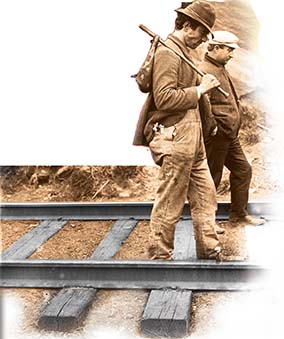SECTION 2: Americans Face Hard Times

◄ Hobos walk along a railroad line.
WITNESS HISTORY  AUDIO
AUDIO
Riding the Rails
As the country plunged deeper into the Great Depression, many young people left home, either out of necessity or to follow their dreams of a better life. Nearly a quarter million teenagers hit the road during the early 1930s, jumping freight trains to ride from town to town. Some looked for work, others thirsted for adventure, but all faced the dangers of the hobo life. Charley Bull, who left his California home at 18, recalled:
“You could ride on top of a freight car and then you just had to be careful. If a train is going sixty or seventy miles an hour and hits a curve and you’re walking and your back’s to the turn and you don’t see it coming—a little tiny turn can throw you right off the train. A lot of people have been killed like that.”
—Charley Bull, from a PBS presentation “The American Experience—Riding the Rails”
Objectives
- Examine the spread of unemployment in America’s cities.
- Discuss the impact of the Great Depression on rural America.
- Explain the human and geographical factors that created the Dust Bowl.
Terms and People
- bread line
- Hooverville
- tenant farmer
- Dust Bowl
- Okies
- repatriation
NoteTaking
Reading Skill: Categorize As you read, use a Venn diagram to note how the Great Depression affected both urban and rural America.
Why It Matters The stock market crash signaled the end of boom times and the beginning of hard times. As investors mourned their losses, Americans watched the economy stagger into the Great Depression. In the cities and on the farms, desperate poverty gripped the nation. Even after prosperity returned, those who lived through the crisis would remember the pain and worries of the depression. Tested by extreme hardship, this generation of Americans forged a character and will strong enough to overcome economic ruin and restore prosperity. Section Focus Question: How did the Great Depression affect the lives of urban and rural Americans?
Misery and Despair Grip America’s Cities
The Great Depression had a deep and lasting impact on the lives of the people who lived through it. Few Americans grasped the underlying problems of the 1920s economy or the subtle reasons for the stock market crash. Fewer still comprehended how the crash led to the Great Depression. But they did understand the impact of the economic crisis. Workers understood having a job one day and being unemployed the next. Whole families knew the shame and fear of losing their homes.
The Great Depression touched every American because every American either experienced or knew someone who experienced the hardships and loss caused by the economic catastrophe. For many, their lives were never the same again.





